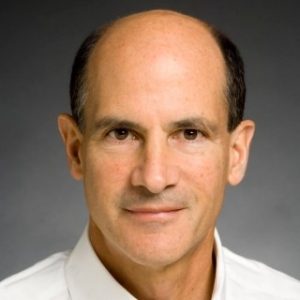 Fasting sends muscle stem cells into a deep resting state that slows muscle repair but also makes them more resistant to stress, according to a Stanford Medicine study of laboratory mice. Thomas Rando, MD, PhD (pictured), director of the Eli and Edythe Broad Center of Regenerative Medicine and Stem Cell Research at UCLA and an affiliated faculty member of the McGowan Institute for Regenerative Medicine, is the study’s lead author.
Fasting sends muscle stem cells into a deep resting state that slows muscle repair but also makes them more resistant to stress, according to a Stanford Medicine study of laboratory mice. Thomas Rando, MD, PhD (pictured), director of the Eli and Edythe Broad Center of Regenerative Medicine and Stem Cell Research at UCLA and an affiliated faculty member of the McGowan Institute for Regenerative Medicine, is the study’s lead author.
The protective effect can also be achieved by feeding the mice high-fat, low-carbohydrate food — also known as a ketogenic diet — that mimics how the body responds to fasting, or by giving the animals ketone bodies, the byproducts that occur when the body uses fat as an energy source.
The research explores how the body responds in times of deprivation and plenty and gives clues about the effect of aging on the ability to regenerate and repair damaged tissue. Although the study focused on muscle stem cells, the researchers believe the findings are applicable to other types of tissue throughout the body.
“As we age, we experience slower and less complete healing of our tissues,” said Dr. Rando, professor of neurology and neurological sciences, recently accepted the director position at the Broad Stem Cell Research Center. “We wanted to understand what controls that regenerative ability and how fasting impacts this process. We found that fasting induces resilience in muscle stem cells so that they survive during deprivation and are available to repair muscle when nutrients are again available.”
The study was published online in Cell Metabolism and instructor Daniel Benjamin, PhD, and graduate student Pieter Both are the lead authors.
Calorie restriction
It’s been well documented that long-term caloric restriction extends the lifespan and promotes the overall health of laboratory animals, but it is difficult for people to maintain a very-low-calorie diet for months or years. Periodic fasting has been explored as another way to obtain the health benefits of caloric restriction, but the effects of intermittent fasting on the body and its ability to regenerate damaged or aging tissues have not been well studied.
Fasting or, alternatively, eating a ketogenic diet high in fat and low in carbohydrates — a popular weight-loss technique — causes the body to enter a state called ketosis, in which fat is the primary energy source. Ketone bodies are the byproducts of fat metabolism.
The researchers found that mice that had fasted between 1 and 2.5 days were less able than non-fasting animals to regenerate new muscle in their hind legs in response to injury. This reduced regenerative capacity persisted for up to three days after the mice began feeding again and returned to a normal body weight; it returned to normal within one week of the end of the fast.
Further research showed that muscle stem cells from fasting animals were smaller and divided more slowly than those from non-fasting animals. But they were also more resilient: They survived better when grown on a lab dish under challenging conditions including nutrient deprivation, exposure to cell-damaging chemicals, and radiation. They also survived transplantation back into animals better than those from non-fasting animals.
“Usually, most laboratory-grown muscle stem cells die when transplanted,” Dr. Rando said. “But these cells are in a deep resting state we call ketone-induced deep quiescence that allows them to withstand many kinds of stress.”
Muscle stem cells isolated from non-fasting animals and then treated with a ketone body called beta-hydroxybutyrate (BHB) displayed a similar resilience as did those from fasting animals, the researchers found. Additionally, muscle stem cells isolated from mice fed a ketogenic diet, or a normal diet coupled with injections of ketone bodies, displayed the same characteristics of the deeply quiescent stem cells from fasting animals.
Finally, the researchers isolated muscle stem cells from old mice that had been treated with ketone bodies for one week. Previous research in Dr. Rando’s lab showed that these aged muscle stem cells grew more poorly in the laboratory than muscle stem cells from younger animals. But treatment with the ketone bodies allowed the old muscle stem cells to survive as well as their younger counterparts.
Potential applications
Although more research needs to be done, the results are intriguing, the researchers said.
“Cells evolved to exist in times of abundance and in times of deprivation,” Dr. Rando said. “They had to be able to survive when food was not readily available. Ketone bodies arise when the body uses fat for energy, but they also push stem cells into a quiescent state that protects them during deprivation. In this state, they are protected from environmental stress, but they are also less able to regenerate damaged tissue.”
Balancing these outcomes might one day help combat normal aging and enhance stem cell function throughout the body, the researchers speculated.
“It would be beneficial if the effects of fasting on stem cells could be attained through ketone bodies, supplanting the need to fast or to eat a ketogenic diet,” Dr. Rando said. “Perhaps it may be possible to eat normally and still get this increased resilience.”
Read more…
Abstract (Fasting induces a highly resilient deep quiescent state in muscle stem cells via ketone body signaling. Daniel I. Benjamin, Pieter Both, Joel S. Benjamin, Christopher W. Nutter, Jenna H. Tan, Jengmin Kang, Leo A. Machado, Julian D.D. Klein, Antoine de Morree, Soochi Kim, Ling Liu, Hunter Dulay, Ludovica Feraboli, Sharon M. Louie, Daniel K. Nomura, Thomas A. Rando. Cell Metabolism, Volume 34, Issue 6, p902-918.e6, June 07, 2022.)
